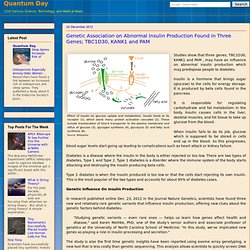

Curing Type 1 Diabetes By Replacing Insulin Producing Beta Cells Through Stem Cell Technology. Scientists have developed a technique that could replenish insulin producing beta cells using stem cell technology.

They used skin cells and transformed them into cells that could secrete insulin. Healthy Lifestyle Advice Same For Diabetics and Non-diabetics. A study published by the German Institute of Human Nutrition Potsdam-Rehbruecke in Nuthetal, Germany suggests that the suggested lifestyle of people with diabetes is not different from the lifestyle advised for the general public.

It is just that diabetics would benefit more from the healthy lifestyle in comparison with non-diabetics. Whole Fruit Diet of Blueberries Grapes and Apples Lower Risk of Diabetes By 23% Based on data gathered between 1984 and 2008 from 187,382 participants, scientists have released a study that show whole fruit diet particularly blueberries, grapes, and apples lowers the risk of type 2 diabetes while fruit juice consumption increases the risk.

The study shows that a daily diet one or more servings of fruit juice increases risk by as high as 21% while 2 servings of whole fruits per week lowers type 2 diabetes risk by 23%. Diabetes is a disease where the body has difficulty in controlling blood sugar (glucose) levels. Newly Discovered Hormone, Betatrophin, May Offer More Effective Diabetes Treatment. The Harvard Stem Cell Institute (HSCI) have recently discovered a new hormone called betatrophin that can lead to a more effective treatment of type 2 diabetes.

In twenty years, diabetes is projected to affect 550 million people all over the world. Currently, it is the number one cause for foot amputations and non-genetic vision impairments. Lactate As An Alternative Energy Source for the Brain. Researchers find that using lactate instead of glucose also works as an alternative energy source for the brain.

Glucose is naturally associated as the main energy source for living tissues but there have been findings that it is lactate that is preferentially metabolized by neurons in the brain. Lactate or lactic acid is a by-product of carbohydrate metabolism. Lactate used to be associated with oxygen depletion after physical exercise, muscle fatigue, and a key factor in acidosis-induced tissue damage. But after various studies and findings, lactate has experienced a 180 degree turnaround.
It is now considered an important factor in cellular, regional and whole body metabolism. The findings may have a major impact on diabetics who have problems with maintaining their glucose levels. Video: How Cells Obtain Energy. Diabetes Patients Taking GLP-1 Based Medication Has Reduced Risk of Heart Failure. A study shows that diabetes patients taking a class of medication targeting the GLP-1 hormone has a reduced risk of heart disease.

Diabetes is one of the most serious health problems around. In the next 20 years, diabetes is expected to affect nearly 552 million people globally. Closed Loop Insulin Delivery System Improves Glucose Control And Reduce Risk of Hypoglycemia For Diabetics. A Closed Loop Insulin Delivery System improved the control of glucose levels and reduced the risk of hypoglycemia compared with conventional pump treatment in a trial published in CMAJ (Canadian Medical Association Journal).

Diabetes is a disease where the body has difficulty maintaining glucose levels in the blood. There is a problem with insulin production. Findings Suggest Beta-Carotene Lowers Risk of Type 2 Diabetes. Scientists at the Stanford University Medical Center published their findings that beta-carotene lowers the risk for type 2 diabetes.

They noted that test subjects with higher beta-carotene levels correlated with lower blood-glucose levels. On the opposite end, they note that a form of vitamin E may increase the risk of acquiring type 2 diabetes. Beta-carotene is an organic pigment found in plants called carotenoids. It comes in red, orange, and yellow pigments. Carotenoids are not manufactured by the body but is obtained through eating carotenoid-rich food.
Carrots are generally associated with beta-carotene but other fruits and vegetables also carry this nutrient. Creating New Beta Cells: Stem Cell Advances For Diabetes Treatment. Stem cell treatment for diabetes is slowly progressing as scientists study the process of regenerating insulin producing beta cells from stem cells.

Diabetes is a disease where production of insulin by the, the hormone that regulates blood sugar levels, is either not enough or not even produced. Insulin is created in the pancreas, as part of the body's endocrine system. Within the pancreas, in a region called the islets of Langerhans are cells called Beta cells. These beta cells are the cells responsible for the actual production and secretion of insulin. Diabetes occurs when these beta cells stop producing insulin or does not produce enough. Genetic Association on Abnormal Insulin Production Found in Three Genes; TBC1D30, KANK1 and PAM. Studies show that three genes, TBC1D30, KANK1 and PAM , may have an influence on abnormal insulin production which may predispose people to diabetes.

Insulin is a hormone that brings sugar (glucose) to the cells for energy storage. It is produced by beta cells found in the pancreas. It is responsible for regulating carbohydrate and fat metabolism in the body. Insulin causes cells in the liver, skeletal muscles, and fat tissue to take up glucose from the blood. When insulin fails to do its job, glucose which is supposed to be stored in cells end up in the blood. Intensive Weight Loss Programs Increases Chance of Remission of Type 2 Diabetes. Rise In Diabetes Major Cause In Increase Of Visual Impairment Cases For Young People. Studies show that cases of visual impairment not due to need for glasses is significantly increasing because of the rise in type 2 diabetes. Obesity is a major contributing factor on the rise of type 2 diabetes among young people. For the past few years, steps have been undertaken to control obesity even going as far as increasing the taxes levied on soda and sugar rich food.
Type 2 diabetes is the most common type of diabetes with 95% of diabetes cases. Obesity, physical inactivity and family history of the disease are the three prime causes of the disease. But with the prevalence of diabetes, also comes its underlying effects and consequences such as vision impairment and a weakened immune system. Countries Using High Fructose Corn Syrup Have 20% More Prevalence of Diabetes. Researchers have found a link between the use of high fructose corn syrup in a country's food source and the spread of type 2 diabetes. High fructose corn syrup (HFCS) are made from corn syrup. The syrup contains glucose (a simple sugar) which is then converted to another more sweeter type of sugar, fructose. Both glucose and fructose are simple sugars that are sweet, colorless, and odorless.
HFCS are commonly used as a sweetener in commercially available foods and beverages. Soda, cereals, candies, and bread are some of the food that use HFCS. Teens Getting Seven Hours Of Sleep Improves Insulin Resistance By 9% Insulin resistance happens when the body does not respond to its own produced insulin. Research Show Relationship Between Intestinal Bacteria and Type 2 Diabetes. The human body is a host to thousands of species of bacteria. The bulk of these bacteria live in the human intestinal tract or the gut. These bacteria perform activities that are beneficial to the body. Bacteria that are not harmful and are beneficial to the body are said to be part of the normal flora. Since "flora" pertains to plants, the term "biota" is also used although generally, flora is an accepted word to describe this microsystem.
Human gut flora, consists of an average of 500 different species. Although the relationship of gut flora and the human body is generally beneficial and mutual, there are certain situations and conditions that bacteria can cause infections, disease, and even cancer. The number of people suffering from type 2 diabetes world-wide has risen rapidly in recent years, and scientists estimate that just as many people could be suffering from the illness without realising it. New Observation On Beta Cells Opens Avenue To New Treatment of Type 2 Diabetes. White Blood Cells Called Neutrophils May Lead To New Treatment of Diabetes.
White blood cells are cells of the body's immune system involved in defending the body against both infectious disease and foreign materials. 50% to 70% of these white blood cells are Neutrophils. Neutrophils are phagocytic. They have the ability to ingest other cells. Diabetes Drug, Pioglitazone, May Cause Bladder Cancer. Successful test of artificial pancreas system, Hypoglycemia Hyperglycemia Minimizer (HHM) System For Type 1 Diabetes. Natural protein Apolipoprotein A-IV (apoA-IV) Potential Target For Diabetes Therapeutic. Apolipoprotein A-IV was discovered in 1977. Combined Metformin and Rosiglitazone Therapy Better For Type 2 Diabetes Than Single Drug Therapy. Osteoporosis Medication May Cause Serious Eye Disease.